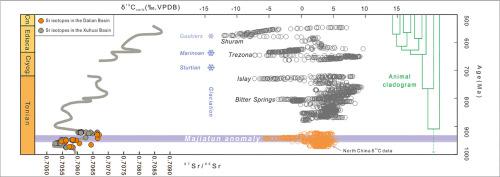Gondwana Research ( IF 7.2 ) Pub Date : 2021-02-16 , DOI: 10.1016/j.gr.2021.01.013 Zhiyue Zhang , Peng Peng , Lianjun Feng , Zheng Gong , Ross N. Mitchell , Youlian Li

|
The Neoproterozoic Era (1000–541 Ma) is characterized by the largest negative carbon isotope excursions in Earth history. Younger Neoproterozoic excursions are well-documented on multiple continental margins and associated with major events including snowball Earth glaciations, ocean-atmosphere oxygenation, and the evolution of animal multicellularity. However, due to a large gap in carbon isotopes before 900 Ma, the onset of early Neoproterozoic carbon cycle volatility has heretofore been obscure. Here, we present a mid-amplitude, negative carbon isotope excursion with δ13C values reaching a nadir of ~ − 6‰ from the Majiatun Formation in the Dalian Basin of the North China Craton dated between 950 and 920 Ma. The whole-rock 87Sr/86Sr ratios of limestone and dolostone are as low as ~0.7055, which is compatible with the Tonian age of the global carbonate curve. Identification of the Majiatun anomaly thus fills the critical gap in carbon isotopes and implies the onset of Neoproterozoic carbon cycle volatility ~130 m.y. earlier than previously thought. Now 5 negative carbon isotope excursions occur with increasing amplitude throughout Neoproterozoic time, implying deeper roots for the biogeochemical processes that may have causally led to late Neoproterozoic snowball glaciation, oxygenation, and biological innovation.











































 京公网安备 11010802027423号
京公网安备 11010802027423号